Shala K. Howell's Blog, page 2
January 15, 2024
A new year, a new approach to Caterpickles
This blog began as an attempt to help me manage my daughter’s 5:1 question to declarative sentence ratio with something like enthusiasm. After all she was inviting me into a conversation and conversations are the heart of most parenting relationships. I wanted to preserve the ability to greet her query-filled conversations with enthusiasm as much as possible. At least until she learned how to have another type.
Reader, it ended up being a lot of fun.
When she started middle school, though, my daughter asked me to stop writing about her so much in public. I didn’t need to take down the old posts, just stop generating new ones.
This is reasonable enough, but as long time readers noticed, posting slowed quite a bit once the blog shifted away from researching and writing about my daughter’s curious questions. Her lively mind is a fount of new material. My own mind is … quieter.
Just over a year ago, I enrolled at San José State University to get a Masters in Library & Information Science (MLIS). My posts about library related things in recent years have proven nearly as popular as the posts answering my daughter’s random questions have been, so I have decided to turn this blog in a more library-oriented direction, and toss in a few posts about stuff I learn in library school along with the usual assortment of book reviews and the occasional question that bubbles up in my slightly-quieter-grownup mind.
So that’s the plan for the blog for now. Reports from my MLIS journey, more book reviews, and an occasional question post. My goal is to post at least once a month while I’m on leave, more when time permits. I guess we’ll see how it goes.
I’m changing my approach to the Caterpickles Bookstore tooI’m changing my approach to the Caterpickles Bookstore. Instead of a place to find static recommendations for books we’ve enjoyed over the years, I’m streamlining it to be a place to tell you about:
Books by the folks at Caterpickles Central A rotating list of fiction books I’ve read in the last month or so that I’ve enjoyed & why I liked them Another rotating list for nonfiction books I’ve read recently that I’ve enjoyed & why I liked them And a third rotating list of books I’m reading now/next & why I am looking forward to reading themA somewhat static list of books that have made me a better parent/adult & why I appreciate themIt’s kind of a bookstore, kind of a mini-review site. The fiction, nonfiction, and books I’m reading next lists will rotate out frequently (I’m limiting them to 6-7 books each, which means when I have a new book I love something’s going to have to go to make room for it).
You can use the shop to purchase copies of these books, or not, as you see fit from Bookshop.org. If you decide to purchase a book through the Caterpickles Shop, I’ll get a small commission. (Why I do this.)
So what’s it like to get an MLIS at the age of Parent-to-a-Teenager?At first, it was wildly hard to work full-time at a library while going to grad school and parenting a teenager. The fact that during the past year I basically only posted here on the blog during school breaks may have already clued you into this.
But my district has an option for employees to take up to 18 months leave to pursue a degree, and since I applied (and was approved) for that, things have been much better.
Turns out I really enjoy spending my days learning things and writing about those things. (Upon reflection, this may also explain why I persist in writing this blog.) Did you know, I even caught myself reading library science related books for fun over break? Shocking.
When I enrolled, I expected to be the oldest in my MLIS classes, and actual experience has borne this out. According to SJSU, 68% of students who received their MLIS in May 2023 were between the ages of 26 and 40. I like to think that means I’m usually not old enough to be my classmate’s parent, but there’s no escaping the fact that I’m older than 68% of the MLIS students I meet, so … ahem.
That said, I’ve met several students who are also getting an MLIS as a career change or as part of a career evolution. I also know that I’m not the only person pursuing a mid-career MLIS at the age of Parent-to-a-Teenager. There are at least five of us. 
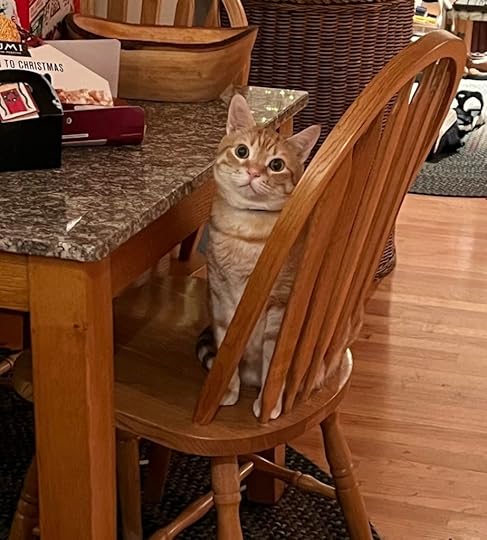 My cat also likes having me around more these days. Here he is, reminding me that it’s time to clear the table for lunch. He’s remarkably good about always sitting in the chairs, and not on the table itself. And yes, he will often either stay in that chair or hop down and enjoy a sociable nibble from his nearby food bowl while I eat. We used to eat lunch together when I worked from home, pre-library days, and it’s nice to have the routine reinstated. (Photo: Shala Howell)
My cat also likes having me around more these days. Here he is, reminding me that it’s time to clear the table for lunch. He’s remarkably good about always sitting in the chairs, and not on the table itself. And yes, he will often either stay in that chair or hop down and enjoy a sociable nibble from his nearby food bowl while I eat. We used to eat lunch together when I worked from home, pre-library days, and it’s nice to have the routine reinstated. (Photo: Shala Howell)Thanks, as always, for reading Caterpickles.
Related Links
“So, Mommyo, what are you going to do about Caterpickles now that I’m in middle school?” (Caterpickles)Update to a past Caterpickles: “Did dinosaurs have belly buttons?” (Caterpickles)Student Experience – MLIS (SJSU School of Information)
January 1, 2024
Happy New Year!
Well, that week went by fast.
I don’t really do New Year’s resolutions anymore, but I do make New Year’s wishes. So here’s to a new year full of happy and peaceful moments like this.
 My husband and daughter taking a moment to enjoy the first moments of a sunset last July. (Photo: Shala Howell)Happy New Year, y’all.
My husband and daughter taking a moment to enjoy the first moments of a sunset last July. (Photo: Shala Howell)Happy New Year, y’all.
December 25, 2023
Merry Christmas to all who celebrate!
The calendar has kept flipping and it is somehow that time again. I know not everyone who reads this blog celebrates Christmas, but I persist in being grateful for each one of you, and hope that you will accept my using today’s holiday as an excuse to say thank you.
Thank you for reading Caterpickles.If you had told me as a student in high school that one day people in 72 countries would have read something that I wrote, I would have expected to be famous. (Reader, I am not famous, that’s just how the internet works.)
What I am, though, is amazed, pleased, and humbled that so many of you have chosen to while away some time reading my blog.
Thank you.
 Gingerbread ornament made by a friend of mine down in Texas. She has a great website full of quilting and sewing tips at English Street Quilting Tutorials & Tips in case you are in the market for that sort of thing. (Photo: Shala Howell)
Gingerbread ornament made by a friend of mine down in Texas. She has a great website full of quilting and sewing tips at English Street Quilting Tutorials & Tips in case you are in the market for that sort of thing. (Photo: Shala Howell)
December 18, 2023
Do acorn woodpeckers kill the trees they use to store nuts?
In my opinion, it’s hard to find a better time of year to go hiking in California. It’s cold enough to keep bugs away, and yet there are plenty of fall leaves and birds to be seen. Case in point, my husband and I went hiking in a wooded area near Portola Valley, California last week and came across a flock of acorn woodpeckers busily stashing acorns into the dead half of a giant tree.
My husband took a lot of pictures of this fascinating and new to us behavior. Our minds were full of questions: Are they storing those nuts? Retrieving them? Did they kill that half of the tree by making all those holes or was that bit already dead before they started drilling?
We stood there watching the birds long enough that our fellow hikers began commenting to us about our own behavior.
“Haven’t you ever seen woodpeckers before?”Reader, yes, I have. But sometimes when you go out and into nature, nature does something so interesting that you want to stop and watch it for a while. In our case, for about twenty minutes. I have seen acorn woodpeckers frequently since moving to California, but I have rarely seen so many when I had such a clear view of what they were doing and how they were working together to do it.
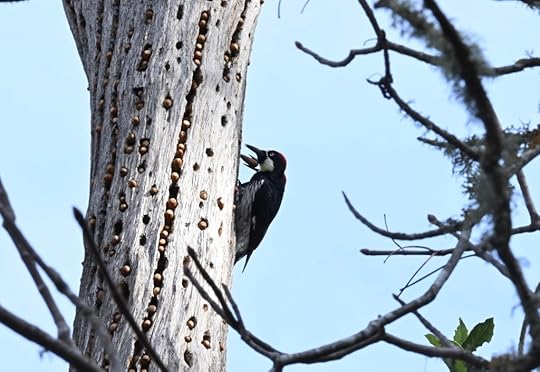 Although at first glance this appears to be a picture of a single woodpecker with two beaks, it’s actually two woodpeckers working side by side. The bird closest to the camera was focused on drilling holes, the second bird was attempting to find the perfect spot for the acorn in its beak. (Photo: Michael Howell)
Although at first glance this appears to be a picture of a single woodpecker with two beaks, it’s actually two woodpeckers working side by side. The bird closest to the camera was focused on drilling holes, the second bird was attempting to find the perfect spot for the acorn in its beak. (Photo: Michael Howell)One of the hikers passing by told us that the acorn woodpeckers were storing nuts for the winter. They like to store them in tight holes, she said. As the acorns dry out, they shrink, so the woodpeckers will move them to a smaller hole to get the right fit. The goal is to have the acorns held tightly enough that squirrels can’t pry them loose. Watching the colony of woodpeckers in action, the hiker’s explanation seemed plausible, but if I’ve learned anything over the years, it’s that I always need to check my sources. Besides, we didn’t think to ask the hiker our real question:
Do acorn woodpeckers kill the trees they use to store all those nuts?I have been casually interested in birds for a long time and have accumulated quite a collection of bird guides at home. So I pulled out four of my guidebooks to North American birds to see what they could tell me about the acorn woodpecker and its December afternoon behavior.
I started with our biggest book, Birds of North America: The Complete Photographic Guide to Every Species from the American Museum of Natural History (2009). It gave us visual confirmation that we had identified the birds correctly. They are definitely acorn woodpeckers. According to this guide, the acorn woodpecker is the only North American woodpecker that stashes nuts in trees for winter snacking. The guide goes so far as to describe their acorn-stashing behavior as “obsessive,” and says that acorn woodpeckers prefer old forests because their trees have softer wood and higher acorn yields.
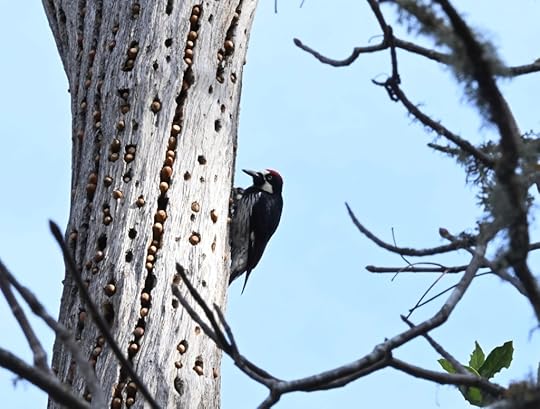 Obsessive? Just because the woodpeckers have already stashed hundreds of nuts in what appears to be vertical stripes all around this one dead tree limb? Rude. (Photo: Michael Howell)
Obsessive? Just because the woodpeckers have already stashed hundreds of nuts in what appears to be vertical stripes all around this one dead tree limb? Rude. (Photo: Michael Howell)From Birds of North America, I also learned that acorn woodpeckers depend on oak trees, so tend to live in areas where there are several types of oak trees. This gives them a backup source of acorns, if one type of oak tree should fail to produce in any given year. This explains why they are so abundant in the Portola Valley, which is home to several types of oak trees, including coast live oaks, blue oaks, tan oaks, black oaks, and canyon live oaks. Lots of choices for the discerning, yet obsessive acorn collector.
The National Audubon Society’s Field Guide to Birds Western Region added the tidbit that acorn woodpeckers don’t just use dead oak branches to stash their hoards, they will also create and maintain their provisions in mature or dead pines, fence posts, or Douglas fir trees, all of which can be found in Portola Valley as well.
Did you know that acorn woodpeckers don’t just eat acorns?I know, all the visual evidence in this post suggests otherwise, but in suburbs and agricultural areas, they will happily gather walnuts and almonds too. For the most part though, acorn woodpeckers treat their hoards of gathered nuts as emergency backup provisions. Only about half of the acorn woodpecker’s diet consists of nuts. They much prefer to eat flying insects whenever they are available. According to our copy of the National Geographic Backyard Guide to the Birds, acorn woodpeckers will also happily snack on ants and sugary tree sap in the spring and summer.
Still, acorn woodpeckers spend a lot of effort on their annual acorn harvest, and they apparently get just as irritated with marauding squirrels as any novice gardener. Acorn woodpeckers pack the nuts as tightly as they can in those little holes to keep the squirrels from stealing them. The guide books also claim that some woodpeckers in the colonies are assigned to guard the stash, attacking squirrels who get too close. Unfortunately, we didn’t get to see any of that in person.
But what about the trees? Do acorn woodpeckers kill their granary trees? Most of Michael’s photos are zoomed in on the birds themselves, for obvious reasons, but in this one you can see that the bird is working on a dead section of an otherwise live tree. (Photo: Michael Howell)
Most of Michael’s photos are zoomed in on the birds themselves, for obvious reasons, but in this one you can see that the bird is working on a dead section of an otherwise live tree. (Photo: Michael Howell)This was all fascinating, but none of it answered our original question. Do acorn woodpeckers kill the trees they use to hoard all those nuts?
Thank goodness our final off-the-shelf bird guide addressed this. The Young Birder’s Guide to Birds of North America (Peterson Field Guides) states that acorn woodpeckers have been known to stash thousands of nuts in a single tree, known as a granary, for later use without killing the tree. Presumably this is because the birds prefer to use already dead branches (or fence posts) as their granaries.
Colonies of acorn woodpeckers work together to create these granaries and will reuse them year after year, but food storage is not the only group project acorn woodpeckers work on in any given year. Several of my guides mentioned that acorn woodpeckers also work collectively to incubate and raise their young. Reading this, I couldn’t help but think of Mama Duck, who did not find Papa Duck’s presence helpful in the least.
Want to read more but don’t want to buy all those books?Cornell Labs’ All about Birds website has a nice entry on Acorn Woodpeckers and their acorn hoarding behavior, which you can find here.
Print References Consulted for this PostAlderfer, J. & Hess, P. (2011). Backyard Guide to the Birds of North America. National Geographic.
Farrand, J., & Udvardy, M.D.F. (2018). National Audubon Society Field Guide to Birds Western Region. Alfred A Knopf.
Thompson, B. (2012). Peterson Field Guides: The Young Birder’s Guide to Birds of North America. Houghton Mifflin Company.
Vuilleumier, F. (Ed.). (2009). Birds of North America: The Complete Photographic Guide to Every Species. American Museum of Natural History.
(Note: The above list includes affiliate links to Bookshop.org. If you use them to purchase books from Bookshop.org, I’ll earn a small commission. Read more about why I decided to use affiliate links here.)
Related LinksNative Trees of Portola Valley (Town of Portola Valley) Acorn Woodpecker (All About Birds, CornellLab).December 14, 2023
3 Great Nonfiction Reads from 2023
It’s the end of the year, which makes it a good time to reflect back on this year’s best reads. Of all of the nonfiction books I read in 2023, here are the three that I find myself talking about most often to family and friends in the real world.
Note: This review contains affiliate links to Bookshop.org. If you use them to purchase books from Bookshop.org, I’ll earn a small commission. Read more about why I decided to use affiliate links here. For EveryoneBy Jason Reynolds
Atheneum Books for Young Readers. April 2, 2019. 112p. $7.99 (paperback).

Middle Grade & Up — Jason Reynolds originally performed For Everyone at the Kennedy Center as part of the unveiling ceremony for the Martin Luther King, Jr. Memorial.
Now available in book form, this lyrical, inspiring, book-length poem reminds us that dreams take time. Dreams take struggle. Dreams are accomplished in stages, so be patient, be persistent, and keep going, even if you have a little fearful voice in your head whispering that it’s too late.
RECOMMENDATION: A perfect gift for graduates or anyone in the midst of a career or midlife transition. Would make a good read-aloud in any graduating (8th grade and up) class.
The Robin Makes a Laughing Sound: A Birder’s ObservationsBy Sallie Wolf
Designed by Micah Bornstein
Charlesbridge Publishing. February 1, 2010. 48p. $11.95 (hardcover).
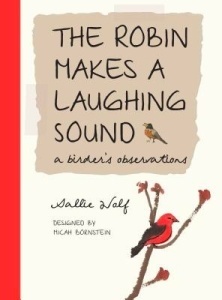
Middle Grade & Up — One of the students at the public middle school library where I worked last spring found this book in our newly revamped nonfiction section, and the title was so wonderful I couldn’t help checking it out for myself when they finished it.
Reading it was a delight, even if the content is hard for me to describe here. Is the book about birds or is it about the wonderful swirling meditative mix of poetry, lists, sketches, and snippets of thought that make up a daily habit of journaling?
Reading the book and scanning the lists of birds and the months they were there made me miss the Chicago area, where the author is from and which is the scene of an amazing bird migration every year.
RECOMMENDATION: Recommended for anyone who enjoys journaling, bird watching, or who draws inspiration from nature.
The AccommodationBy Jim Schutze
Foreword by John Wiley Price
La Reunion Publishing. September 28, 2021. 272p. $30 (hardcover).
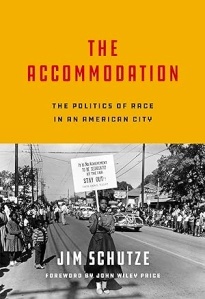
Adult — Originally recommended to me by my brother, this is possibly the one nonfiction book I’ve spent the most time thinking about this year. It tells the checkered history of civil rights in Dallas from the perspective of a journalist who spent his career reporting on Dallas politics for the Dallas Times Herald, The Dallas Observer, D Magazine, and the Houston Chronicle. The book, originally published in 1987 but quickly suppressed, wove together a lot of threads about things I observed while I was growing up there but didn’t fully understand. I remembered many of the players from reading the Dallas Morning News in high school, and found myself pausing this book at several points to look up some of the others.
When I was done, I handed a copy of this book to my daughter full of sticky notes about our family’s intersections with it (my dad was part of the software engineer migration down to Dallas in the 1980s, Ross Perot’s company awarded me a scholarship that partially funded my undergraduate studies at Rice, etc.).
RECOMMENDATION: A good pick for readers interested in reading a career political journalist’s take on a side of Dallas city history that literally didn’t make the news (after being pulled in 1987, this book remained out of print for decades), or simply curious to understand why Dallas wasn’t the scene of more civil unrest during the 1960s and 1970s.
Related Links
Making our nonfiction section more accessible (Caterpickles)What did Dallas learn from rediscovering a suppressed book? (Los Angeles Review of Books)More Book Reviews on CaterpicklesIntroducing the Caterpickles Bookstore and a word about affiliate links on Caterpickles (Caterpickles)December 7, 2023
Intermittent masking is harder than I expected
Before I say anything else:
Yes, I still mask in public indoor spaces and crowded outdoor ones. For me, masks are easy to wear and seem to work. No, my reasons for masking aren’t things you need to worry about. No, I don’t ask that folks around me wear a mask. Yes, I know that my “you do you and I’ll do me” attitude toward masking does not reflect the way infectious diseases work, but it does reflect the way our society works, so there it is. Yes, I know living in California makes all of this much easier. I don’t know if I would still being meeting friends in parks and eating outdoors at restaurants, for example, if I still lived in Boston, Chicago, or Texas, where the weather makes being outside impossible / life-threatening for a good chunk of every year. Masking every day for work was easier than whatever this isOne of the things that surprised me about going on leave from my public middle school library is how much harder masking is now that I’m no longer doing it 8 hours a day, 5 days a week in a space where my role is both well-defined and valued. I thought I’d be relieved to go back to only having to mask every once in a while, but it turns out intermittent masking as Random Community Member is much more emotionally and cognitively draining than wearing a mask to work every day. At my public middle school, my N95 was just part of my work uniform, like my school ID which I wore slung on a lanyard around my neck.
But now that I’m mostly working from the house again, I mask much less often. Seems like it should be easier, right?
Nope. I’m constantly having to assess situations and whether or not they rise to the level of wearing a mask in the face of social pressure and side eye. (Do I really need a mask if I’m only going to be in a room with 5-8 people? What if the windows are open? What if our group is on a sheltered porch with two open walls but no wind? Is it rude to put on a mask if someone in the group starts sneezing or just too late?)
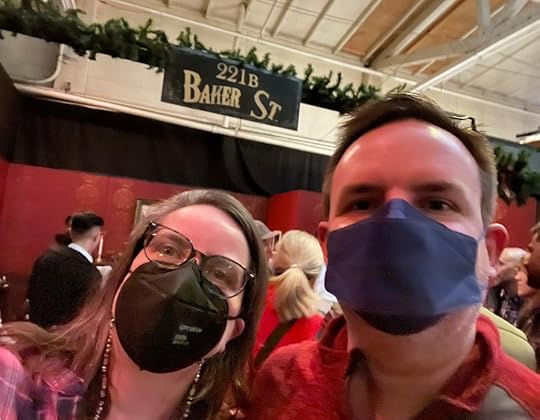 Michael and I at the 2023 Great Dickens Fair in San Francisco. The whole event was crowded & indoors, which was a shame, because the food looked yummy and was not available to go. Organizers should think about adding an outdoor picnic spot next year. (Photo: Shala Howell)So why bother?
Michael and I at the 2023 Great Dickens Fair in San Francisco. The whole event was crowded & indoors, which was a shame, because the food looked yummy and was not available to go. Organizers should think about adding an outdoor picnic spot next year. (Photo: Shala Howell)So why bother? A friend of mine asked the other day why I was still masking and meeting friends outdoors. Why bother when I’m going to catch Covid eventually anyway?
I told her that I still mask because for my family, nothing has changed. The vaccines are helpful for reducing the risk of hospitalization and death, but they don’t prevent all infections and they certainly didn’t cure the things that made Covid infections problematic for my family in the first place. Our goal is still to catch Covid as infrequently as possible, and masks and ventilation are two of the tools we use to accomplish it.
She seemed taken aback by this.
But it’s true. I still really hate being sick. I learned during the mask mandates that I can both tolerate masking and use masks to be sick less often. Colds are annoying. Flu can take me weeks to recover from. Covid is terrible. I don’t want to spend my time on any of that. Masking in high-risk situations, so far, has helped me reduce the amount of time I spend feeling terrible. Yay.
 No masks needed on hikes… a definite benefit. (Photo: Shala Howell)Am I going to mask forever?
No masks needed on hikes… a definite benefit. (Photo: Shala Howell)Am I going to mask forever?¯\_(ツ)_/¯
I don’t know. Guess we’ll find out? Maybe one day we’ll have clean air standards for indoor spaces as well, and masking won’t be as helpful. Or maybe life will change in some other way that makes masking irrelevant — or more socially acceptable. I am not a futurist.
For now, masking seems to work for me. I hate being sick more than I hate side-eye, and I’m willing to push through the extra cognitive and emotional load it takes to keep masking. But yeah, it’s definitely harder now that I only mask sometimes.
On that note, the CDC says it’s a good time to wear masks againStill, as Michael said way back in 2013, “The immune system helps those who help themselves.”
– Daddyo’s Winter Survival Tip: “Don’t Taunt the Hand Plague.” Caterpickles (11 March 2013)
In case you missed it, the new CDC Director Mandy Cohen released a PSA this week saying that respiratory illness level across the country is high again, and that if you don’t want to spend your holiday season being sick, you can:
Wash your handsWear a maskGet this year’s flu & Covid shotsGet vaccinated against RSV, if you’re over 60, or in certain stages of pregnancy (see your doctor for timing)Stay home, test, and seek treatment if you’re sickImprove airflow and ventilation by opening windows/bringing in fresh outdoor air, using air filters, and meeting outside when possibleThat’s right. The CDC, which told us we could vax and relax until they told us otherwise, is now telling us otherwise. Specifically, they want us to consider masking in public indoor spaces until the current respiratory season with its rising wave of colds, flus, RSV, Covid-19, and pneumonia passes.
Here’s a link to the video in the only place I’ve seen it, in case you’d like to watch it for yourself. But be aware that I’ve only found it on X-Twitter so far, so if you are avoiding that place, you may not want to click through.
The CDC also has a Community Resources page that you can use to track flu, RSV, and Covid-19 levels in your area. Here’s today’s snapshot from that page for respiratory virus activity in Santa Clara County, California.
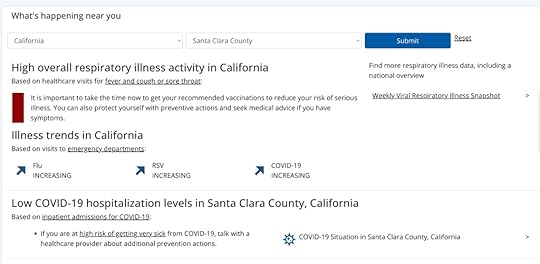 As you can see, flu, RSV, and Covid-19 are all on the rise, although for now, Covid-19 hospitalizations remain low. Fingers crossed. (Source: CDC).
As you can see, flu, RSV, and Covid-19 are all on the rise, although for now, Covid-19 hospitalizations remain low. Fingers crossed. (Source: CDC).Stay safe out there, and thanks for stopping by Caterpickles.
Related Links:
Protect yourself and others from COVID-19, Flu, and RSV (CDC)National Wastewater Surveillance System (CDC): Use to see track Covid levels in your stateDaddyo’s Winter Survival Tip: “Don’t taunt the hand plague” (Caterpickles)November 24, 2023
Navigating the social media hellscape
First, happy belated Thanksgiving. I hope your days were better than anticipated. Our Thanksgivings have been low-key since I’ve been in grad school. Since my semester ends a week or 2 after Thanksgiving, all of my final projects are due about now so there is no traveling to major family festivities. We have been, as Jane Austen wrote in Emma, “a very quiet set of people, I believe; more disposed to stay at home than engage in schemes of pleasure” at Thanksgiving these past two years. Although we did engage in a wickedly fun round of Competition Kitchen while the turkey breast was roasting.
But to get to the point of the post…
The implosion of Twitter and the rise of about 20-zillion alternatives, has me thinking about why I should even bother with social media at all. What function does it serve for me, and are there other ways to fulfill it?
I’ve been doing a bunch of reading as I consider how to use social media going forward & I found a couple of posts useful. The first is from Teri Kanefield.
In her post she goes into the weeds a bit about algorithms and walled gardens and the impact our daily diet of social-media fueled outrage & misinformation has on our democracy.
The part that stuck with me is this:
“I was recently interviewed by a person who called herself a progressive. She was shocked that I didn’t agree with everything she said (she repeated to me many of the statements listed here). When I pushed back and tried to explain what was wrong with her statements, many of which were Internet Triggers, she became visibly upset and later in private said unkind things to me. This woman considers herself well-informed and hosts a podcast. My sense was that she lives in a social media bubble where (1) she is constantly triggered and (2) her triggers are continuously confirmed by those around her. Her expectation was that I, too, would confirm her beliefs. When I didn’t, she could only react with anger.”
“Confirmation bias + algorithms encourage extremism by encouraging people to hold narrow views and reject nuance.”
For the record she is not talking about me here, but it got me thinking about whether she could have been.
The second post is from John Scalzi, a writer I’ve followed for a long time on Twitter because frankly he’s quite entertaining there, who recently posted on his blog, Whatever, his plans for social media use going forward.
In the post he talks about what types of content the various sites are suited for, and how he intends to use them. His TL;DR for writers: have your own place on the web that you own and control because everything else is transitory. For him that’s his blog, which at 25 years, has outlasted everything else he’s tried so far.
I’m sure I’ll read more before deciding on my final plan. For now I’m claiming my name on various sites & lurking to get a feel for those places. I’ll post here when I decide my actual social media plan to tell folks which sites I’ve landed on and how I plan to use them.
Right now, though, I am leaning toward a strategy of “reclaiming my time.”
I used to hate Twitter. But over time it evolved into a surprisingly useful social media site for me. It was one place I could go to learn about publishing, writing, books, libraries, science, medicine, news, dinosaurs – all my random interests curated for me by people I’ve followed for a while and whose biases I’d gotten a feel for even if I didn’t always share them. I got to have conversations-however fleeting-with writers and librarians and other experts in their fields that I admire and constantly learn from.
I’ll miss that.
But over the summer I realized that checking Twitter just made me mad. Teri Kanefield points out that this is what it’s supposed to do but the moment I realized logging into Facebook and Instagram just led to me being in a really bad mood after was the moment I stopped logging into Facebook & Instagram. I’ve still got accounts there but don’t invest much energy on them. I visit every three months or so just to check for messages from folks who don’t have other ways to reach me.
That’s what I’ve been doing lately with Twitter as well. Keep my name but no longer feed the beast. Scalzi points out that writers really need to have a web house they own, a constant. For him it’s his blog, Whatever, which has been running for 25 years.
For me that’s Caterpickles, which I’ve been writing on and off for 13(!) years. I’ve missed writing it regularly, and plan to return to a more regular posting schedule next year.
Writing it makes me happy, and happy is a precious thing right now.
What I’m going to do about news and how I’ll replace my daily feed of niche learning interests… ¯\_(ツ)_/¯ Podcasts? We don’t have cable anymore. Are newspapers and magazines and blogs still a thing? Does Feedly work to compile them? OMG AM I GOING TO HAVE TO READ THINGS ON PAPER?
TL;DR: I’m claiming my name on a bunch of social media, but my heart belongs to my blog Caterpickles (caterpickles.com), so that’s where my time will go also. Also planning to do more old school newspaper, magazine, blog, and book reading. Some podcast listening. So retro.
How are y’all thinking through this?
Taking a final cue from Scalzi, a snuggly cat pic as thanks for reading this.
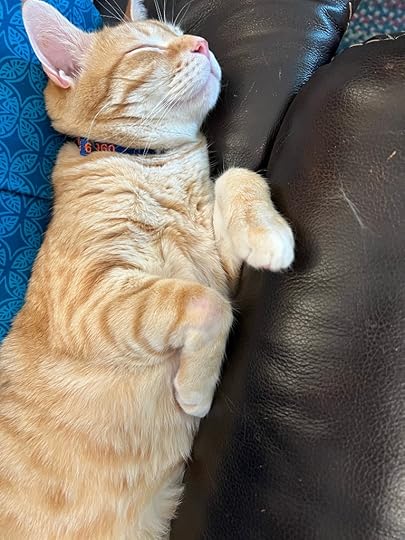 Canelo thinks time is best spent in snuggly warm naps. (Photo: Shala Howell)
Canelo thinks time is best spent in snuggly warm naps. (Photo: Shala Howell)
August 15, 2023
A Belated Year-End Report for 2022-2023
I can’t remember whether this is one of the places I’ve announced it or not, but I am currently on leave from my job at the local public middle school library so that I can go to grad school full-time. The choice for me at this stage of life was relatively straightforward. I can either work 50-70 hour weeks for 5 years to get my Masters in Library Science (MLIS) degree while continuing to work at the middle school library, or I can take an 18-month leave, go to grad school full-time and be done with my MLIS in 2 years. This latter option has the side benefit of allowing time to do whatever parenting the now 16-year-old still requires.
School started at my former middle school last week and I have to tell you, I have two feelings about this. TL;DR: OMG I miss working in the library so much and I am so happy to be able to decide for myself how to use each day. So, you know, the usual blend of things.
I realized this morning as I watched the troops of middle schoolers walking down the street to begin their new school year that I never did post my year-end report from last year. I did one, of course, as a complement to the Teacher Librarian’s main annual report. I posted it outside the library the last week of school for students and staff to view. My Teacher Librarian also published it along with her annual report in all of her usual spots, but I forgot to post it here. Let’s fix that, shall we?
The 2022-23 School Year in NumbersAs you may remember, at the end of the 2021-2022 school year, I spent a week rebalancing all of the books in our fiction, graphic novel, series, story collection, audiobook, and nonfiction collections to eliminate gaps created by weeding and to create space to put as many forward-facing books on display as possible. (Completing this in a week was made possible by the fact that my daughter volunteered to come in and relabel everything.)
During the 2021-2022 school year, we typically had 300 books on display at any given time. By the time my daughter and I were done rearranging everything, we had space to keep 1500 books (or 10% of our collection) on more or less permanent display throughout our library.
In practical terms, this meant the library went from looking like this: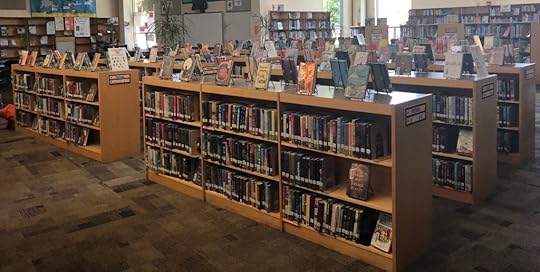 The library as it looked on opening day August 2021. In the foreground are the fiction stacks. Each stack has 12 books on display on top. Most of the shelves underneath are packed with spine-out books. One or two of them have one face-out book, but the bulk of the display books in the fiction section are the ones on display on top of the stacks. In the background, you can see the nonfiction stacks. In 2021-2022, the nonfiction section had a few face-forward books, but for the most part our nonfiction section was wall after wall of spine-out books. Great for storage. Bad for browsing. (Photo: Shala Howell)To this:
The library as it looked on opening day August 2021. In the foreground are the fiction stacks. Each stack has 12 books on display on top. Most of the shelves underneath are packed with spine-out books. One or two of them have one face-out book, but the bulk of the display books in the fiction section are the ones on display on top of the stacks. In the background, you can see the nonfiction stacks. In 2021-2022, the nonfiction section had a few face-forward books, but for the most part our nonfiction section was wall after wall of spine-out books. Great for storage. Bad for browsing. (Photo: Shala Howell)To this:
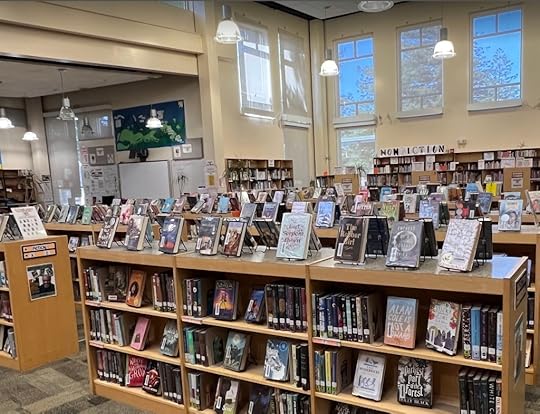 The library as it looked on opening day in August 2022. We increased the number of books on display on top of the fiction shelves to 18, and as you can see, there are now 2-3 forward-facing books on display on every shelf underneath. We also added forward-facing books to every nonfiction shelf in the background, although it is harder to see that in this photo. (Photo: Shala Howell)
The library as it looked on opening day in August 2022. We increased the number of books on display on top of the fiction shelves to 18, and as you can see, there are now 2-3 forward-facing books on display on every shelf underneath. We also added forward-facing books to every nonfiction shelf in the background, although it is harder to see that in this photo. (Photo: Shala Howell)My hope in doing all this was to boost total circulation and make the library feel like a more inviting and welcoming place to be. So did it work? Let’s look at the numbers.
 12,186: The number of print books checked out or used in-house
12,186: The number of print books checked out or used in-houseDuring the 2022-23 school year, 12,186 print books were checked out or used in-house. That’s almost 23 books per student, and a healthy increase over last year’s print circulation of 8996 books (roughly 17 books per student).
(Note: In the 2021-2022 report, I reported total circulation of 13,975. That number included both print and ebook circulation. Midway through 2022-2023, our ebook provider stopped reporting ebook usage by school, so it became impossible to tell which ebooks had actually been used by students at my school, so I couldn’t include ebook usage in my total circulation for 2022-2023.)
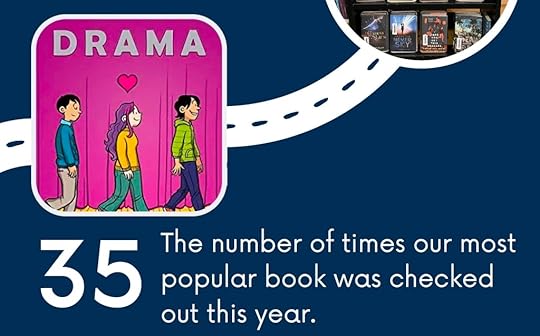 35: The number of times our most popular book was checked out during the 2022-23 school year
35: The number of times our most popular book was checked out during the 2022-23 school yearOur most popular book during the 2022-2023 school year was Raina Telgemeier’s Drama. Students checked out Drama 35 times that year. Other popular books included:
Refugee by Alan Gratz (WWII historical fiction) The Hate U Give by Angie Thomas (realistic fiction) One of Us is Lying by Karen McManus (mystery) Living with Viola by Rosena Fung (graphic novel) Spinning by Tillie Walden (graphic novel memoir) Out of My Mind by Sharon Draper (realistic fiction) The Magic Fish by Trung Le Nguyen (graphic novel) To All the Boys I’ve Loved Before by Jennie Han (romance) New Kid by Jerry Craft (graphic novel) Hunger Games by Suzanne Collins (fantasy / dystopian)Every book on this list was checked out more than 20 times over the course of the 2022-2023 school year.
(Note: The above paragraph and list includes affiliate links to Bookshop.org. If you use them to purchase books from Bookshop.org, I’ll earn a small commission. Read more about why I decided to use affiliate links here.)
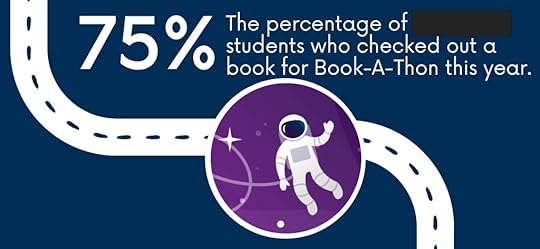 75%: The percentage of students who checked out a book for Book-a-Thon this year
75%: The percentage of students who checked out a book for Book-a-Thon this yearOur big reading event, Book-a-Thon, happens during the Spring Semester. For Book-a-thon, we ask students to check out (and read) at least one book for fun between mid-January and early March. There are no book reports, although we do ask students to fill out a Google Form telling us the number of books they read and as many of their titles as they can remember.
Students who both check out a book and remember to fill out the form are entered into a raffle to receive one of more than 100 prizes donated by faculty and staff. Most years, we get a participation rate of between 50-60%. This year, 75% of the student body checked out a book during Book-a-Thon. I am pretty proud of that.
Naturally, they didn’t all remember to turn in their forms. Still, 67% of the student body both checked out a book and remembered to fill out a form telling us about it. (For comparison, only 53% of the student body both checked out a book during Book-A-Thon and submitted a form telling us about it in 2021-2022. Definite improvement there.)
 6880: The number of short stories printed from our short story machine
6880: The number of short stories printed from our short story machineWe are one of the few (only?) public middle schools in the U.S. to have a Short Édition short story dispenser. The students love it and use it constantly. Teachers frequently come by (or send a student) to grab a story from it as well. We have a block schedule which features 90-minute classes, and some of our teachers have gotten into the habit of using 3 or 5 minute stories from our machine as brain breaks in the middle of class.
Our Short Story Machine is also the centerpiece of our three yearly Short Story and Art contests. We publish the winning entries to our Spooky (October), Winter (January), and Spring (April) Writing / Art contests on our machine. After we announce the winners, there is always a rush of students coming in to print out their own copies of their classmates’ work from the machine.
Last year, students and teachers printed 6880 short stories and comics from our Short Story machine – roughly 13 short stories per student (Spooky!)
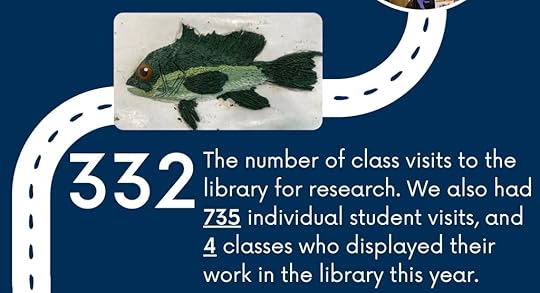 332: The number of class visits to the library in 2022-23
332: The number of class visits to the library in 2022-23During the 2022-23 school year, 332 classes visited the library to work on various research projects. We also had 735 individual student visits to check out books, work in smaller groups, or do homework. Four classes (Spanish, Marine Biology, Drama, and Art) used the library as a mini-art gallery to display artwork of various types this year. It was absolutely wonderful to have students come into the library to admire and discuss their schoolmates’ work.
In short, it was a wonderful year, and I enjoyed every minute of it. Fingers crossed for 2023-2024.
Related Links:
A year-end report and why it matters (Caterpickles)August 10, 2023
Lahaina
Like so many, we here at Caterpickles Central are heartbroken at the news coming out of Lahaina. It is almost impossible to contemplate the scale of the destruction caused by these wildfires.
The love we feel for Maui and Lahaina is the product of visits over the years. We cannot imagine how much greater the loss and grief must be for those who call Maui and Lahaina home.
You are in our thoughts today.
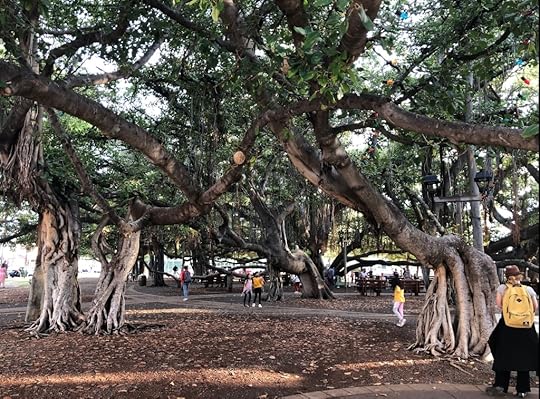 My daughter, under the canopy of Lahaina’s historic banyan tree in December 2021. (Photo: Shala Howell)
My daughter, under the canopy of Lahaina’s historic banyan tree in December 2021. (Photo: Shala Howell)Related Links:
Lahaina’s historic banyan tree is scarred, but standing (New York Times)Hawaii Wildfires: Survivors describe ‘Total Inferno’ that engulfed West Maui (New York Times)June 29, 2023
(School) Year-end nonfiction project update
Hello! *taps screen* Is this thing on?
After a quieter than expected blogging season, I’m back. A few things have happened since my last post, and I’m here at last to tell you about some of them.
What happened with our 2022-23 nonfiction project?Library assistants in my school district typically work five or six days after school gets out prepping the library for the summer, and if time permits, for the reopening of school in the fall.
As you may remember, I spent that week last year reorganizing the nonfiction section to make it more independently browse-able during the 2022-23 school year. In the process, I rebalanced the shelves, selected 1-3 books with interesting covers to display face-forward on every shelf, updated and increased signage to make it easier for students to find topics they were interested in, and once school started, was relentless about incorporating nonfiction books into as many book displays as possible.
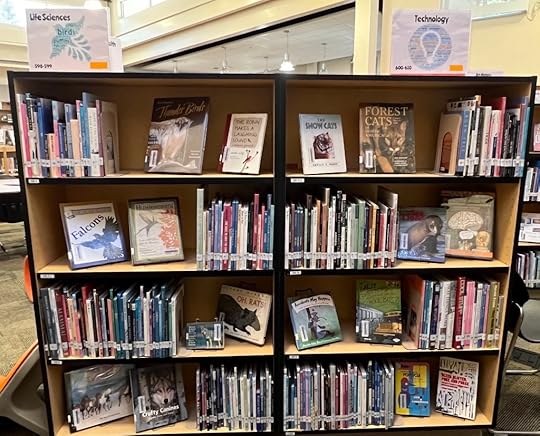 A typical revamped bookshelf in our nonfiction section. To decide which books to display face-out, I looked for relatively recent acquisitions with interesting or engaging covers, as well as books that reflected the range of topics on that shelf and could therefore serve as landmarks for browsers. I also gave preference to diverse perspectives whenever possible and of course, to books that the students themselves frequently checked out and therefore, presumably, found interesting or useful. (Photo: Shala Howell)
A typical revamped bookshelf in our nonfiction section. To decide which books to display face-out, I looked for relatively recent acquisitions with interesting or engaging covers, as well as books that reflected the range of topics on that shelf and could therefore serve as landmarks for browsers. I also gave preference to diverse perspectives whenever possible and of course, to books that the students themselves frequently checked out and therefore, presumably, found interesting or useful. (Photo: Shala Howell) Meanwhile, my Teacher Librarian gave tours of the nonfiction section to incoming students at the start of the new school year, invited our science and social studies teachers to bring their classes in to find interesting nonfiction choice reads throughout the year, and dedicated the last week of the first semester to hosting a Nonfiction Book Cafe for the science classes to showcase the variety of books we have in our nonfiction collection.
The Nonfiction Book Cafe was how we discovered the previously untapped but deep and abiding interest in cookbooks among our student population. Sadly, I did not get a photo of the table with all of the cookbooks because frankly I was not expecting the intense interest it would generate. I did, however, get photos of two of our other tables, the “Fun with Science” table and a slightly picked over version of the “Wait…Did that REALLY Happen?” table next to it.
 The Fun with Science table featured books on a wide range of science topics, including robotics, space, dinosaurs, geology, and of course, how to spot misinformation in science communications. (Photo: Shala Howell)
The Fun with Science table featured books on a wide range of science topics, including robotics, space, dinosaurs, geology, and of course, how to spot misinformation in science communications. (Photo: Shala Howell)We kept the Book Cafe layout very simple, as you can see. I had some fun making the signs using royalty-free images sourced from Pixabay, but otherwise we focused our energy on curating a collection of interesting books in each category to entice readers:
Fun with ScienceWait… Did that REALLY Happen?Cook and Bake Over BreakArts & EntertainmentPlagues & Pestilence: Medicine Then & NowSports & GamesDuct Tape & Doodling. Our “Wait…Did that REALLY Happen?” table included a wide range of biography and history books such as Lies My Teacher Told Me by James Loewen, The Beloved World of Sonia Sotomayor by Sonia Sotomayor, You May Not Tie an Alligator to a Fire Hydrant by Jeff Koon, and How They Choked: Failures, Flops, and Flaws of the Awfully Famous by Georgia Bragg. (Photo: Shala Howell)
Our “Wait…Did that REALLY Happen?” table included a wide range of biography and history books such as Lies My Teacher Told Me by James Loewen, The Beloved World of Sonia Sotomayor by Sonia Sotomayor, You May Not Tie an Alligator to a Fire Hydrant by Jeff Koon, and How They Choked: Failures, Flops, and Flaws of the Awfully Famous by Georgia Bragg. (Photo: Shala Howell)We checked out a lot of books that day, but more importantly, the event sparked an interest in our nonfiction collection, particularly in our cooking, crafting, and drawing books, that continued throughout the rest of the year.
So did it work?During the 2021-22 school year, 1505 print* nonfiction books were either checked out by students or used in-house to support various class projects. Roughly 533 students attended our school that year, giving us a per-student nonfiction circulation of 2.8 books per student.
During the 2022-23 school year, print nonfiction circulation jumped to 3754, while our student population increased to 545 students, giving us a per-student nonfiction circulation of roughly 6.9 books per student.
That’s … pretty great.
(*Midway through the year, our ebook service provider stopped reporting ebook usage by individual school site and lumped all of the ebook usage at the middle school level into a single district-wide number. It was impossible for me to figure out how much of that middle grade reading had been done by students at my school, so I was forced to switch to simply tracking print circulation.)
Related Links:
Nonfiction project update (Caterpickles)Making our nonfiction section more browse-able (Caterpickles)


